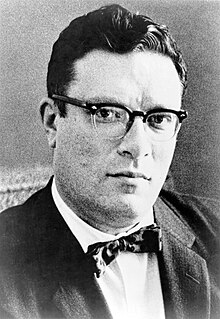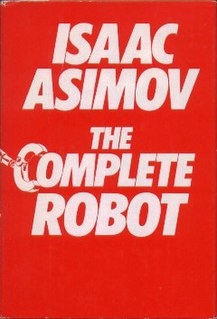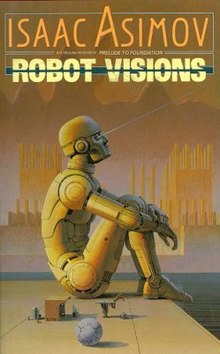
I, Robot is a fixup novel of science fiction short stories or essays by American writer Isaac Asimov. The stories originally appeared in the American magazines Super Science Stories and Astounding Science Fiction between 1940 and 1950 and were then compiled into a book for stand-alone publication by Gnome Press in 1950, in an initial edition of 5,000 copies. The stories are woven together by a framing narrative in which the fictional Dr. Susan Calvin tells each story to a reporter in the 21st century. Although the stories can be read separately, they share a theme of the interaction of humans, robots, and morality, and when combined they tell a larger story of Asimov's fictional history of robotics.

Isaac Asimov was an American writer and professor of biochemistry at Boston University. He was known for his works of science fiction and popular science. Asimov was a prolific writer, and wrote or edited more than 500 books. He also wrote an estimated 90,000 letters and postcards.

The Robot series is a series of 37 science fiction short stories and six novels by American writer Isaac Asimov, featuring positronic robots.

The Three Laws of Robotics are a set of rules devised by science fiction author Isaac Asimov. The rules were introduced in his 1942 short story "Runaround", although they had been foreshadowed in some earlier stories. The Three Laws, quoted from the "Handbook of Robotics, 56th Edition, 2058 A.D.", are:

The Complete Robot (1982) is a collection of 31 of the 37 science fiction short stories about robots by American writer Isaac Asimov, written between 1939 and 1977. Most of the stories had been previously collected in the books I, Robot and The Rest of the Robots, while four had previously been uncollected and the rest had been scattered across five other anthologies. They share a theme of the interaction of humans, robots and morality, and put together tell a larger story of Asimov's fictional history of robotics. The stories are grouped into categories.

Robot Dreams (1986) is a collection of science fiction short stories by American writer Isaac Asimov, illustrated by Ralph McQuarrie. The title story is about Susan Calvin's discovery of a robot with rather disturbing dreams. It was written specifically for this volume and inspired by the McQuarrie cover illustration. All of the other stories had previously appeared in various other Asimov collections. Four of the stories are robot stories, while five are Multivac stories.
"Robbie" is a science fiction short story by American writer Isaac Asimov. It was his first robot story and writing commenced on June 10, 1939. It was first published in the September 1940 issue Super Science Stories magazine as "Strange Playfellow", a title that was chosen by editor Frederik Pohl and described as "distasteful" by Asimov. A revised version of Robbie was reprinted under Asimov's original title in the collections I, Robot (1950), The Complete Robot (1982), and Robot Visions (1990). "Robbie" was the fourteenth story written by Asimov, and the ninth to be published. The story is also part of Asimov's Robot series, and was the first of Asimov's positronic robot stories to see publication.
"Little Lost Robot" is a science fiction short story by American writer Isaac Asimov. It was first published in the March 1947 issue of Astounding Science Fiction and reprinted in the collections I, Robot (1950), The Complete Robot (1982), Robot Dreams (1986), and Robot Visions (1990).
"Escape!" is a science fiction short story by American writer Isaac Asimov. It was first published as "Paradoxical Escape" in the August 1945 issue of Astounding Science Fiction and reprinted as "Escape!" in the collections I, Robot (1950) and The Complete Robot (1982).
"Evidence" is a science fiction short story by American writer Isaac Asimov. It was first published in the September 1946 issue of Astounding Science Fiction and reprinted in the collections I, Robot (1950), The Complete Robot (1982), and Robot Visions (1990).
See also: Isaac Asimov bibliography (categorical), Isaac Asimov bibliography (chronological)
This is a list of short stories by American writer Isaac Asimov. Asimov is principally known for his science fiction, but he also wrote mystery and fantasy stories.
"Someday" is a science fiction short story by American writer Isaac Asimov. It was first published in the August 1956 issue of Infinity Science Fiction and reprinted in the collections Earth Is Room Enough (1957), The Complete Robot (1982), Robot Visions (1990), and The Complete Stories, Volume 1 (1990).
"Insert Knob A in Hole B" is a science fiction short story by Isaac Asimov. The story was first published in the December 1957 issue of The Magazine of Fantasy and Science Fiction and reprinted in the 1969 collection Nightfall and Other Stories.
William F. Wu is a Chinese-American science fiction, fantasy, and crime author.

The Asimov Chronicles: Fifty Years of Isaac Asimov is a collection of short science fiction stories, mystery stories and science essays by American writer Isaac Asimov, published by Dark Harvest in May 1989.
In a writing career spanning 53 years (1939–1992), science fiction and popular science author Isaac Asimov (1920–1992) wrote and published 40 novels, 383 short stories, over 280 non-fiction books, and edited about 147 others.

Nebula Awards 22 is an anthology of award winning science fiction short works edited by George Zebrowski, the third of three successive volumes under his editorship. It was first published in hardcover and trade paperback by Harcourt Brace Jovanovich in April 1988.
Depending on the counting convention used, and including all titles, charts, and edited collections, there may be currently over 500 books in Isaac Asimov's bibliography— as well as his individual short stories, individual essays, and criticism. For his 100th, 200th, and 300th books, Asimov published Opus 100 (1969), Opus 200 (1979), and Opus 300 (1984), celebrating his writing.

Opus 300 is a collection by American writer and scientist Isaac Asimov. It was published by Houghton Mifflin in the United States in 1984, and by Robert Hale Ltd in the United Kingdom in 1985. Asimov chose to celebrate the publication of his three hundredth book by writing about his previous 99 books, including excerpts from short stories and novels, as well as nonfiction articles and books. Opus 300 also includes nine complete stories, several complete science essays, and one complete essay never before published, "The Forever Generation," which is not available anywhere else.









